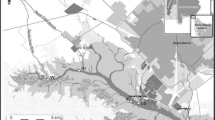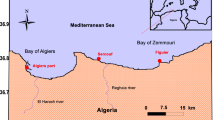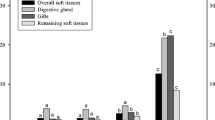Abstract
This research paper focused on the monitoring of marine sites using mussels, which are highly valuable organisms in assessing environmental health. However, a significant challenge arises when determining the appropriate size of mussels for monitoring purposes. The objective of this study was to examine the levels of Cd, Pb, As, and Co in three different size classes of two mussel species, Mytilus galloprovincialis and Perna perna, collected from three sites along the Algerian coast, each exhibiting varying degrees of pollution.
At each of the study sites, a total of thirty individuals from small, medium, and large size classes of mussels were collected during four different time periods. The mussels were then dissected, and the concentrations of Cd, Pb, As, and Co were measured in the entire flesh of the mussels using ICP-MS.
Across the various study sites, the concentrations of cadmium, lead, arsenic, and cobalt ranged from 0.06 to 1.32 mg/kg, 0.09 to 12.56 mg/kg, 4.23 to 18.31 mg/kg, and 0.11 to 1.85 mg/kg, respectively. Interestingly, the distribution of these metals in the three different size classes of mussels followed a consistent pattern at all the study sites. Large mussels exhibited higher concentrations, while small and medium-sized mussels displayed lower levels. These findings highlight substantial spatial and temporal variations in metal concentrations within the studied sites.





Similar content being viewed by others
Data availability
All data generated or analyzed during this study are included in this published article.
Change history
04 December 2023
A Correction to this paper has been published: https://doi.org/10.1007/s11356-023-31319-5
References
Abderrahmani K, Boulahdid M, Bendou N, Aissani A (2020) Seasonal distribution of cadmium, lead, nickel, and magnesium in several tissues of mussels from the Algerian coasts. Environ Sci Pollut Res 27:22547–22567
Abderrahmani K, Boulahdid M, Bendou N, Guenachi B, Hacene OR, Masino F, Montevecchi G (2021) Partitioning of trace elements in the tissues of Mediterranean mussels (Mytilus galloprovincialis) sampled from industrial sites along the Algerian coast. Mar Pollut Bull 173:113006
AIEA (2004) Training workshop on the analysis of trace metals in biological and sediment samples. In: 2004 Laboratory Procedure Book, International Atomic Energy Agency Marine Environment Laboratory, p 45
Akhtar N, Amin-ul Mannan M (2020) Mycoremediation: expunging environmental pollutants. Biotechnol Rep 26:e00452
Algerie (2011) MINISTÈRE DE LA PECHE ET DES RESSOURCES HALIEUTIQUES, Arrêté interministériel du 30Moharram 1432 correspondant au 5 janvier 2011 fixant les seuils limites de présence de contaminants chimiques, microbiologiques et toxicologiques dans les produits de pêche et de l’aquaculture, Journal officiel, n° 25, 23 Joumada El Oula 1432 correspondant au 27 avril 2011, p 19
Alissa EM, Ferns GA (2011) Heavy metal poisoning and cardiovascular disease. J Toxicol 2011:870125
Amadi CN, Frazzoli C, Orisakwe OE (2020) Sentinel species for biomonitoring and biosurveillance of environmental heavy metals in Nigeria. J Environ Sci Health 38(1):21–60. https://doi.org/10.1080/26896583.2020.1714370
Andreyeva AY, Lobko VV, Gostyukhina OL, Tkachuk AA, Murashova AI, Malakhova LV, Kladchenko ES (2023) Accumulation, functional and antioxidant responses to acute exposure to Di (2-ethylhexyl) phthalate (DEHP) in Mytilus galloprovincialis. Mar Pollut Bull 191:114923
Aroua M, Boulahdid M, Radakovitch O, Benhalima M, Guendouzi Y, Fowler SW, Ambrosi JP (2023) Sediment pollution: an assessment of anthropogenic and geogenic trace element contributions along the central Algerian coast. Mar Pollut Bull 186:114398
Avio CG, Pittura L, d’Errico G, Abel S, Amorello S, Marino G, Gorbi S, Regoli F (2020) Distribution and characterization of microplastic particles and textile microfibers in Adriatic food webs: general insights for biomonitoring strategies. Environ Pollut 258:113766
Azizi G, Akodad M, Baghour M, Layachi M, Moumen A (2018) The use of Mytilus spp. mussels as bioindicators of heavy metal pollution in the coastal environment A review. J Mater Environ Sci 9(4):1170–1181
Benjamin ED, Jeffs A, Handley SJ, Toone TA, Hillman JR (2023) Determining restoration potential by transplanting mussels of different size classes over a range of aerial exposures. Mar Ecol Prog Ser 713:71–81. https://doi.org/10.3354/meps14337
Beyer J, Green NW, Brooks S, Allan IJ, Ruus A, Gomes T, Brate ILN, Schøyen M (2017) Blue mussels (Mytilus edulis spp.) as sentinel organisms in coastal pollution monitoring: a review. Mar Environ Res 130:338–365
Cai J, Leung PS (2022) Unlocking the potential of aquatic foods in global food security and nutrition: a missing piece under the lens of seafood liking index. Glob Food Sec 33(6):100641
Chelyadina NS, Kapranov SV, Popov MA et al (2023) The mussel Mytilus galloprovincialis (Crimea, Black Sea) as a source of essential trace elements in human nutrition. Biol Trace Elem Res. https://doi.org/10.1007/s12011-023-03607-1
Danabaş D, Kutluyer F, Ural M et al (2022) Age- and sex-specific bioaccumulation of selected metals in freshwater mussel (Unio elangatulus eucirrus Bourguignat, 1860) populating from Keban Dam Lake (Elazig, Turkey). Bull Environ Contam Toxicol 108:366–371. https://doi.org/10.1007/s00128-021-03414-1
Doucet CV, Labaj AL, Kurek J (2021) Microfiber content in freshwater mussels from rural tributaries of the Saint John River, Canada. Water Air Soil Pollut 232:32
Duan Y, Yang J, Guo Y, Wu X, Tian Y, Li H, Awasthi MK (2021) Pollution control in biochar-driven clean composting: emphasize on heavy metal passivation and gaseous emissions mitigation. J Hazard Mater 420:126635
Foong CY, Wirzal MDH, Bustam MA (2020) A review on nanofibers membrane with amino-based ionic liquid for heavy metal removal. J Mol Liq 297:111793
Goher ME, Ali MHH, El-Sayed SM (2019) Heavy metals contents in Nasser Lake and the Nile River, Egypt: an overview, The Egyptian. J Aquat Res 45(4):301–312
Gomez-Delgado AI, Tibon J, Silva MS, Lundebye A-K, Agüera A, Rasinger JD, Strohmeier T, Sele V (2023) Seasonal variations in mercury, cadmium, lead and arsenic species in Norwegian blue mussels (Mytilus edulis L.) – assessing the influence of biological and environmental factors. J Trace Elements Med Biol 76:127110
Goswami KP, Pugazhenthi G (2020) Credibility of polymeric and ceramic membrane filtration in the removal of bacteria and virus from water: a review. J Environ Manag 268:110583
Hu XF, Chan HM (2021) Seafood consumption and its contribution to nutrients intake among Canadians in 2004 and 2015. Nutrients 13:77. https://doi.org/10.3390/nu13010077
Huang J, Zhou C, Xu F, Luo X, Huang X, Huang Z, Yu W, Xun P, Wu Y, Lin H (2022) Effects of partial replacement of fish meal with porcine meat meal on growth performance, antioxidant status, intestinal morphology, gut microflora and immune response of juvenile golden pompano (Trachinotus ovatus). Aquaculture 561:738646
Impellitteri F, Yunko K, Martyniuk V, Matskiv T, Lechachenko S, Khoma V, Faggio C (2023) Physiological and biochemical responses to caffeine and microplastics in Mytilus galloprovincialis. Sci Total Environ 890:164075
Jeong Y-R, Park J-S, Nkurunziza D, Cho Y-J, Chun B-S (2021) Valorization of blue mussel for the recovery of free amino acids rich products by subcritical water hydrolysis. J Supercrit Fluids 169:105135
Jomova K, Makova M, Alomar SY, Alwasel SH, Nepovimova E, Kuca K, Rhodes CJ, Valko M (2022) Essential metals in health and disease. Chem Biol Interact 1(367):110173. https://doi.org/10.1016/j.cbi.2022.110173
Ju YR, Chen CF, Chuang XY, Lim YC, Chen CW, Dong CD (2020) Biometry-dependent metal bioaccumulation in aquaculture shellfishes in southwest Taiwan and consumption risk. Chemosphere 253:126685
Kaiser HF (1958) The varimax criterion for analytic rotation infactor analysis. Psychometrika 23(3):187–200. https://doi.org/10.1007/BF02289233
Kapranov SV, Kozintsev AF, Bobko NI, Ryabushko VI (2023) Elements in soft tissues of the young Mediterranean mussel Mytilus galloprovincialis Lam. 1819 collected in Sevastopol Bay (Crimea, Black Sea): effects of age, sex, location, and principal morphometric parameters. Animals 13:1950. https://doi.org/10.3390/ani13121950
Klasios N, Frond HD, Miller E, Sedlak M, Rochman CM (2021) Microplastics and other anthropogenic particles are prevalent in mussels from San Francisco Bay, and show no correlation with PAHs. Environ Pollut 271:116260
Koehn JZ, Allison EH, Golden CD, Hilborn R (2022) The role of seafood in sustainable diets. Environ Res Lett 17:035003
Köşker AR, Gündoğdu S, Ayas D, Bakan M (2022) Metal levels of processed ready-to-eat stuffed mussels sold in Turkey: health risk estimation. J Food Compos Anal 106:104326
Kumar P, Kumar M, Bedi O et al (2021) Role of vitamins and minerals as immunity boosters in COVID-19. Inflammopharmacol 29:1001–1016. https://doi.org/10.1007/s10787-021-00826-7
Li J, Lusher AL, Rotchell JM, Deudero S, Turra A, Bråte ILN, Sun C, Hossain MS, Li Q, Kolandhasamy P, Shi H (2019) Using mussel as a global bioindicator of coastal microplastic pollution. Environ Pollut 244:522–533
Lv Y, Wei Y, Zhou J, Xue K, Guo Y, Liu Y, Ju A, Wu B, Zhao F, Chen C, Xiong J, Li C, Gu H, Cao Z, Ji JS, Shi X (2021) Human biomonitoring of toxic and essential metals in younger elderly, octogenarians, nonagenarians and centenarians: analysis of the healthy ageing and biomarkers cohort study (HABCS) in China. Environ Int 156:106717
Macali A, Bergami E (2020) Jellyfish as innovative bioindicator for plastic pollution. Ecol Ind 115:106375
Maes GE, Raeymaekers JAM, Pampoulie C, Seynaeve A, Goemans G, Belpaire C, Volckaert FAM (2005) The catadromous European eel Anguilla anguilla (L.) as a model for freshwater evolutionary ecotoxicology: relationship between heavy metal bioaccumulation, condition and genetic variability. Aquat Toxicol 73(1):99–114
Malmsten A, Dalin AM, Pettersson J et al (2021) Concentrations of cadmium, lead, arsenic, and some essential metals in wild boar from Sweden. Eur J Wildl Res 67:18. https://doi.org/10.1007/s10344-021-01460-y
Melinda T, Samosir AM, Sulistiono, Simanjuntak CPH (2021) IOP Conf Ser: Earth Environ Sci 800:012015. https://doi.org/10.1088/1755-1315/800/1/012015
Mititelu M, Neacșu SM, Oprea E, Dumitrescu DE, Nedelescu M, Drăgănescu D, Nicolescu TO, Roșca AC, Ghica M (2022) Black sea mussels qualitative and quantitative chemical analysis: nutritional benefits and possible risks through consumption. Nutrients 14:964. https://doi.org/10.3390/nu14050964
Moyen NE, Somero GN, Denny MW (2020) Mussel acclimatization to high, variable temperatures is lost slowly upon transfer to benign conditions. J Exp Biol 223(13):jeb222893
Mukherjee S, Boral S, Siddiqi H, Mishra A, Meikap BC (2021) Present cum future of SARS-CoV-2 virus and its associated control of virus-laden air pollutants leading to potential environmental threat – a global review. J Environ Chem Eng 9(2):104973
Multisanti CR, Merola C, Perugini M, Aliko V, Faggio C (2022) Sentinel species selection for monitoring microplastic pollution: a review on one health approach. Ecol Ind 145:109587
Naik AS, Hayes M (2019) Bioprocessing of mussel by-products for value added ingredients. Trends Food Sci Technol 92:111–121
Nedelescu M, Stan M, Ciobanu A-M, Bălălău C, Filippini T, Baconi D (2022) Attention deficit among preschool and school-aged children living near former metal-processing plants in Romania. Environ Res 208:112689
Peycheva K, Panayotova V, Stancheva R, Makedonski L, Merdzhanova A, Cicero N, Camilleri G, Fazio F (2021) Trace elements and omega-3 fatty acids of Black Sea (Bulgaria) bivalve species Mytilus galloprovincialis, Chameleagallina and Donaxtrunculus. Human health risk. Nat Prod Res. https://doi.org/10.1080/14786419.2021.1921770
Pham DN, Clark L, Li M (2021) Microplastics as hubs enriching antibiotic-resistant bacteria and pathogens in municipal activated sludge. J Hazard Mater Lett 2:100014
Qari R, Ajiboye O, Manzoor R, Afridi AR (2015) Seasonal variation in occurrence of heavy metals in Perna Viridis from Manora Channel of Karachi, Arabian Sea. Int J Mar Sci 5(45):1–13
Rajendran S, Priya TAK, Khoo KS, Hoang TKA, Ng H-S, Munawaroh HSH, Karaman C, Orooji Y, Show PL (2022) A critical review on various remediation approaches for heavy metal contaminants removal from contaminated soils. Chemosphere 287(4):132369
Rasheed T, Shafi S, Bilal M, Hussain T, Sher F, Rizwan K (2020) Surfactants-based remediation as an effective approach for removal of environmental pollutants—a review. J Mol Liq 318:113960
Riget F, JohAnsen P, Asmund G (1996) Influence of length on element concentrations in the blue mussels (Mytilus edulis). Mar Pollut Bull 32:745–751
Sami M, Ibrahim NK, Mohammad DA (2020) Impact of the size of commercial bivalves on bioaccumulation and depuration of heavy metals. Egypt J Aquat Biol Fish 24(7):553–573
Shi J, Li X, He T, Wang J, Wang Z, Li P, Lai Y, Sanganyado E, Liu W (2018) Integrated assessment of heavy metal pollution using transplanted mussels in eastern Guangdong, China. Environ Pollut. https://doi.org/10.1016/j.envpol.2018.09.006
Tanaviyutpakdee P, Karnpanit W (2023) Exposure assessment of heavy metals and microplastic-like particles from consumption of bivalves. Foods 12(16):3018
Tang WL, Evans D, Kraemer L, Zhong H (2017) Body size-dependent Cd accumulation in the zebra mussel Dreissena polymorpha from different routes. Chemosphere 168:825e831
Tardy A-L, Pouteau E, Marquez D, Yilmaz C, Scholey A (2020) Vitamins and minerals for energy, fatigue and cognition: a narrative review of the biochemical and clinical evidence. Nutrients 12(1):228. https://doi.org/10.3390/nu12010228
Thakare M, Sarma H, Datar S, Roy A, Pawar P, Gupta K, Pandit S, Prasad R (2021) Understanding the holistic approach to plant-microbe remediation technologies for removing heavy metals and radionuclides from soil. Curr Res Biotechnol 3:84–98
USFDA (2001) Fish and fisheries products hazards and control guidance, 3rd edn. http://www.cfsan.fda.gov/*comm/haccp4i.html. Accessed Sept 2023
Xu XY, Wong CY, Tam NFY, Liu HM, Cheung SG (2020) Barnacles as potential bioindicator of microplastic pollution in Hong Kong. Mar Pollut Bull 154:111081
Yap CK, Ismail A, Tan SG (2009) Effect of body size on heavy metal contents and concentrations in green-lipped mussel Perna viridis (Linnaeus) from Malaysian coastal waters. Pertanika J Sci Technol 17(1):61–68
Yi YZ, Azman S, Primus A, Said MIM, Abideen MZ (2021) Microplastic ingestion by crabs. (Available on: https://www.researchgate.net/profile/AudreyPrimus2/publication/359481086_Microplastic_Ingestion_by_Crabs/links/623ed07b7931cc7ccff8484c/Microplastic-Ingestion-by-Crabs.pdf). Accessed Apr 2023
Yona D, Sartimbul A, Rahman MA, Sari SHJ, Mondal P, Hamid A, Humairoh T (2021) Bioaccumulation and health risk assessments of heavy metals in mussels collected from madura strait, Indonesia. Jurnal Ilmiah Perikanan Dan Kelautan 13(1):20–28
Zhang H, Yuan X, Xiong T, Wang H, Jiang L (2020) Bioremediation of co-contaminated soil with heavy metals and pesticides: influence factors, mechanisms and evaluation methods. Chem Eng J 398:125657
Zhelyazkova G, Yankovska-Stefanovab T, Minevac E, Stratevd D, Vashind I, Dospatlieve L, Valkovaf E, Popovag T (2018) Risk assessment of some heavy metals in mussels (Mytilus galloprovincialis) and veined rapa whelks (Rapana venosa) for human health. Mar Pollut Bull 128:197–201
Lin Z, Xu X, Chen M, Tan R, Guo Q (2021) Measuring metal uptake and loss in individual organisms: a novel double stable isotope method and its application in explaining body size effects on cadmium concentration in mussels. Environ Sci Technol 55(14):9979–9988
Zhong H, Kraemer L, Evans D (2013) Influence of body size on Cu bioaccumulation in zebra mussels Dreissena polymorpha exposed to different sources of particle-associated Cu. J Hazard Mater 261:746e752
Zoroddu MA, Aaseth J, Crisponi G, Medici S, Peana M, Nurchi VM (2019) The essential metals for humans: a brief overview. J Inorg Biochem 195:120–129
Author information
Authors and Affiliations
Contributions
Khaled Abderrahmani: conceptualization, methodology, analysis, writing, revision. Mouloud Dahdouh: methodology, resources, analysis. Kamel Boudjema: writing, reviewing, supervision. Belkacem Guenachi: writing, reviewing. Giuseppe Montevecchi: writing, reviewing, supervision.
Corresponding author
Ethics declarations
Ethical approval and consent to participate
Not applicable.
Consent to publication
Not applicable.
Competing interests
The authors declare no competing interests.
Additional information
Responsible Editor: Philippe Garrigues
Publisher's Note
Springer Nature remains neutral with regard to jurisdictional claims in published maps and institutional affiliations.
The original online version of this article was revised: Figure 2 is missing 2 images in the published proof.
Rights and permissions
Springer Nature or its licensor (e.g. a society or other partner) holds exclusive rights to this article under a publishing agreement with the author(s) or other rightsholder(s); author self-archiving of the accepted manuscript version of this article is solely governed by the terms of such publishing agreement and applicable law.
About this article
Cite this article
Abderrahmani, K., Dahdouh, M., Boudjema, K. et al. Assessment of toxic trace elements (Cd, Pb, As, and Co) in small, medium, and large individuals of Mytilus galloprovincialis and Perna perna mussel species along the Algerian coast. Environ Sci Pollut Res 30, 123274–123285 (2023). https://doi.org/10.1007/s11356-023-31029-y
Received:
Accepted:
Published:
Issue Date:
DOI: https://doi.org/10.1007/s11356-023-31029-y




